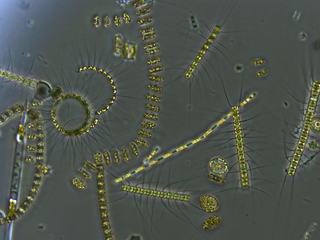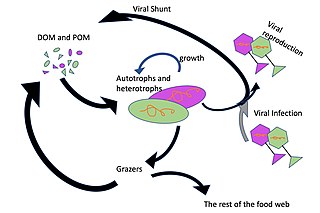Related Research Articles

A biogeochemical cycle,or more generally a cycle of matter,is the movement and transformation of chemical elements and compounds between living organisms,the atmosphere,and the Earth's crust. Major biogeochemical cycles include the carbon cycle,the nitrogen cycle and the water cycle. In each cycle,the chemical element or molecule is transformed and cycled by living organisms and through various geological forms and reservoirs,including the atmosphere,the soil and the oceans. It can be thought of as the pathway by which a chemical substance cycles the biotic compartment and the abiotic compartments of Earth. The biotic compartment is the biosphere and the abiotic compartments are the atmosphere,lithosphere and hydrosphere.

The iron cycle (Fe) is the biogeochemical cycle of iron through the atmosphere,hydrosphere,biosphere and lithosphere. While Fe is highly abundant in the Earth's crust,it is less common in oxygenated surface waters. Iron is a key micronutrient in primary productivity,and a limiting nutrient in the Southern ocean,eastern equatorial Pacific,and the subarctic Pacific referred to as High-Nutrient,Low-Chlorophyll (HNLC) regions of the ocean.
Methylotrophs are a diverse group of microorganisms that can use reduced one-carbon compounds,such as methanol or methane,as the carbon source for their growth;and multi-carbon compounds that contain no carbon-carbon bonds,such as dimethyl ether and dimethylamine. This group of microorganisms also includes those capable of assimilating reduced one-carbon compounds by way of carbon dioxide using the ribulose bisphosphate pathway. These organisms should not be confused with methanogens which on the contrary produce methane as a by-product from various one-carbon compounds such as carbon dioxide. Some methylotrophs can degrade the greenhouse gas methane,and in this case they are called methanotrophs. The abundance,purity,and low price of methanol compared to commonly used sugars make methylotrophs competent organisms for production of amino acids,vitamins,recombinant proteins,single-cell proteins,co-enzymes and cytochromes.
Photoheterotrophs are heterotrophic phototrophs—that is,they are organisms that use light for energy,but cannot use carbon dioxide as their sole carbon source. Consequently,they use organic compounds from the environment to satisfy their carbon requirements;these compounds include carbohydrates,fatty acids,and alcohols. Examples of photoheterotrophic organisms include purple non-sulfur bacteria,green non-sulfur bacteria,and heliobacteria. These microorganisms are ubiquitous in aquatic habitats,occupy unique niche-spaces,and contribute to global biogeochemical cycling. Recent research has also indicated that the oriental hornet and some aphids may be able to use light to supplement their energy supply.

The important sulfur cycle is a biogeochemical cycle in which the sulfur moves between rocks,waterways and living systems. It is important in geology as it affects many minerals and in life because sulfur is an essential element (CHNOPS),being a constituent of many proteins and cofactors,and sulfur compounds can be used as oxidants or reductants in microbial respiration. The global sulfur cycle involves the transformations of sulfur species through different oxidation states,which play an important role in both geological and biological processes. Steps of the sulfur cycle are:

Dissolved organic carbon (DOC) is the fraction of organic carbon operationally defined as that which can pass through a filter with a pore size typically between 0.22 and 0.7 micrometers. The fraction remaining on the filter is called particulate organic carbon (POC).
Heterotrophic picoplankton is the fraction of plankton composed by cells between 0.2 and 2 μm that do not perform photosynthesis. They form an important component of many biogeochemical cycles.

The microbial loop describes a trophic pathway where,in aquatic systems,dissolved organic carbon (DOC) is returned to higher trophic levels via its incorporation into bacterial biomass,and then coupled with the classic food chain formed by phytoplankton-zooplankton-nekton. In soil systems,the microbial loop refers to soil carbon. The term microbial loop was coined by Farooq Azam,Tom Fenchel et al. in 1983 to include the role played by bacteria in the carbon and nutrient cycles of the marine environment.
The microbial food web refers to the combined trophic interactions among microbes in aquatic environments. These microbes include viruses,bacteria,algae,heterotrophic protists. In aquatic ecosystems,microbial food webs are essential because they form the basis for the cycling of nutrients and energy. These webs are vital to the stability and production of ecosystems in a variety of aquatic environments,including lakes,rivers,and oceans. By converting dissolved organic carbon (DOC) and other nutrients into biomass that larger organisms may eat,microbial food webs maintain higher trophic levels. Thus,these webs are crucial for energy flow and nutrient cycling in both freshwater and marine ecosystems.

In taxonomy,Roseobacter is a genus of the Rhodobacteraceae. The Roseobacter clade falls within the{alpha}-3 subclass of the class Alphaproteobacteria. The first strain descriptions appeared in 1991 which described members Roseobacterlitoralis and Roseobacterdenitrificans,both pink-pigmented bacteriochlorophyll a-producing strains isolated from marine algae. The role members of the Roseobacter lineage play in marine biogeochemical cycles and climate change cannot be overestimated. Roseobacters make up 25% of coastal marine bacteria and members of this lineage process a significant portion of the total carbon in the marine environment. Roseobacter clade plays an important role in global carbon and sulphur cycles. It can also degrade aromatic compounds,uptake trace metal,and form symbiotic relationship. In term of its application,Roseobacter clade produces bioactive compounds,has been used widely in aquaculture and quorum sensing.
Sulfur is metabolized by all organisms,from bacteria and archaea to plants and animals. Sulfur can have an oxidation state from -2 to +6 and is reduced or oxidized by a diverse range of organisms. The element is present in proteins,sulfate esters of polysaccharides,steroids,phenols,and sulfur-containing coenzymes.

Bacterioplankton refers to the bacterial component of the plankton that drifts in the water column. The name comes from the Ancient Greek word πλανκτος,meaning "wanderer" or "drifter",and bacterium,a Latin term coined in the 19th century by Christian Gottfried Ehrenberg. They are found in both seawater and freshwater.
Aerobic anoxygenic phototrophic bacteria (AAPBs) are Alphaproteobacteria and Gammaproteobacteria that are obligate aerobes that capture energy from light by anoxygenic photosynthesis. Anoxygenic photosynthesis is the phototrophic process where light energy is captured and stored as ATP. The production of oxygen is non-existent and,therefore,water is not used as an electron donor. They are widely distributed marine bacteria that may constitute over 10% of the open ocean microbial community. They can be particularly abundant in oligotrophic conditions where they were found to be 24% of the community. Aerobic anoxygenic phototrophic bacteria are photoheterotrophic (phototroph) microbes that exist in a variety of aquatic environments. Most are obligately aerobic,meaning they require oxygen to grow. One aspect of these bacteria is that they,unlike other similar bacteria,are unable to utilize BChl (bacteriochlorophyll) for anaerobic growth. The only photosynthetic pigment that exists in AAPB is BChl-a. Anaerobic phototrophic bacteria,on the contrary,can contain numerous species of photosynthetic pigments like bacteriochlorophyll-a. These bacteria can be isolated using carotenoid presence and medias containing organic compounds. Predation,as well as the availability of phosphorus and light,have been shown to be important factors that influence AAPB growth in their natural environments. AAPBs are thought to play an important role in carbon cycling by relying on organic matter substrates and acting as sinks for dissolved organic carbon. There is still a knowledge gap in research areas regarding the abundance and genetic diversity of AAPB,as well as the environmental variables that regulate these two properties.
Ruegeria pomeroyi is a species of Gram-negative,rod-shaped,aerobic dimethylsulfoniopropionate-demethylating bacterium. Its type strain is DSS-3T. Its genome has been sequenced.

Marine biogeochemical cycles are biogeochemical cycles that occur within marine environments,that is,in the saltwater of seas or oceans or the brackish water of coastal estuaries. These biogeochemical cycles are the pathways chemical substances and elements move through within the marine environment. In addition,substances and elements can be imported into or exported from the marine environment. These imports and exports can occur as exchanges with the atmosphere above,the ocean floor below,or as runoff from the land.
Dinoroseobacter shibae is a facultative anaerobic anoxygenic photoheterotroph belonging to the family,Rhodobacteraceae. First isolated from washed cultivated dinoflagellates,they have been reported to have mutualistic as well as pathogenic symbioses with dinoflagellates.

The viral shunt is a mechanism that prevents marine microbial particulate organic matter (POM) from migrating up trophic levels by recycling them into dissolved organic matter (DOM),which can be readily taken up by microorganisms. The DOM recycled by the viral shunt pathway is comparable to the amount generated by the other main sources of marine DOM.

The hydrothermal vent microbial community includes all unicellular organisms that live and reproduce in a chemically distinct area around hydrothermal vents. These include organisms in the microbial mat,free floating cells,or bacteria in an endosymbiotic relationship with animals. Chemolithoautotrophic bacteria derive nutrients and energy from the geological activity at Hydrothermal vents to fix carbon into organic forms. Viruses are also a part of the hydrothermal vent microbial community and their influence on the microbial ecology in these ecosystems is a burgeoning field of research.
Elizabeth Kujawinski is an American oceanographer who is Senior Scientist at the Woods Hole Oceanographic Institution,where she works as Program Director of the Center for Chemical Currencies of a Microbial Planet. Her research considers analytical chemistry,chemical oceanography,microbiology and microbial ecology. She is interested in what controls the composition of organic materials in aquatic systems.
Alison Buchan is the Carolyn Fite Professor at the University of Tennessee. She is known for her work on bacteria in natural environments,especially bacteria within the Roseobacter group. In 2022 she was named as a fellow of the American Academy of Microbiology.
References
- 1 2 3 4 5 "David C. White". davidcwhite.org. Retrieved 2016-11-01.
- ↑ "Mary Ann Moran | Marine Sciences & Oceanography at University of Georgia – Athens, Georgia". www.marsci.uga.edu. Retrieved 2016-11-01.
- ↑ "Research Awards | Mary Ann Moran". research.uga.edu. 2016-02-23. Retrieved 2016-11-01.
- 1 2 3 4 5 6 7 8 9 10 11 12 13 14 15 16 "Moran Lab". moranresearch.uga.edu. Retrieved 2016-11-01.
- ↑ "2021 NAS Election". www.nasonline.org. Retrieved 2021-04-26.
- ↑ Moran, Mary Ann; Maccubbin, A. E.; Benner, Ronald; Hodson, Robert E. (1987). "Dynamics of microbial biomass and activity in five habitats of the Okefenokee Swamp ecosystem". Microbial Ecology. 14 (3): 203–217. Bibcode:1987MicEc..14..203M. doi:10.1007/BF02012941. ISSN 0095-3628. PMID 24202715. S2CID 7022372.
- ↑ "Mary Ann Moran - Google Scholar Citations". scholar.google.com. Retrieved 2016-11-01.
- 1 2 3 "The importance of soil organic matter". www.fao.org. Retrieved 2016-11-01.
- ↑ "Soil Health – Organic matter". www.soilhealth.com. 2012-01-01. Retrieved 2016-11-01.
- ↑ "Glossary: Natural organic matter". www.greenfacts.org. Retrieved 2016-11-04.
- ↑ McDowell, William H (2003-05-01). "Dissolved organic matter in soils—future directions and unanswered questions". Geoderma. Ecological aspects of dissolved organic matter in soils. 113 (3–4): 179–186. Bibcode:2003Geode.113..179M. doi:10.1016/S0016-7061(02)00360-9.
- ↑ "biogeochemical cycle | science". Encyclopædia Britannica. Retrieved 2016-11-01.
- ↑ "the definition of biogeochemical cycle". Dictionary.com. Retrieved 2016-11-01.
- 1 2 3 4 5 Durham, Bryndan P.; Sharma, Shalabh; Luo, Haiwei; Smith, Christa B.; Amin, Shady A.; Bender, Sara J.; Dearth, Stephen P.; Mooy, Benjamin A. S. Van; Campagna, Shawn R. (2015-01-13). "Cryptic carbon and sulfur cycling between surface ocean plankton". Proceedings of the National Academy of Sciences. 112 (2): 453–457. Bibcode:2015PNAS..112..453D. doi: 10.1073/pnas.1413137112 . ISSN 0027-8424. PMC 4299198 . PMID 25548163.
- ↑ Buchan, Alison; González, José M.; Moran, Mary Ann (2005-10-01). "Overview of the Marine Roseobacter Lineage". Applied and Environmental Microbiology. 71 (10): 5665–5677. Bibcode:2005ApEnM..71.5665B. doi:10.1128/AEM.71.10.5665-5677.2005. ISSN 0099-2240. PMC 1265941 . PMID 16204474.
- ↑ González, José M.; Simó, Rafel; Massana, Ramon; Covert, Joseph S.; Casamayor, Emilio O.; Pedrós-Alió, Carlos; Moran, Mary Ann (2000-10-01). "Bacterial Community Structure Associated with a Dimethylsulfoniopropionate-Producing North Atlantic Algal Bloom". Applied and Environmental Microbiology. 66 (10): 4237–4246. Bibcode:2000ApEnM..66.4237G. doi:10.1128/AEM.66.10.4237-4246.2000. ISSN 0099-2240. PMC 92291 . PMID 11010865.
- 1 2 "UGA scientists discover missing links in the biology of cloud formation over the oceans". www.moore.org. Retrieved 2016-11-04.
- 1 2 Howard, Erinn C.; Henriksen, James R.; Buchan, Alison; Reisch, Chris R.; Bürgmann, Helmut; Welsh, Rory; Ye, Wenying; González, José M.; Mace, Kimberly (2006-10-27). "Bacterial Taxa That Limit Sulfur Flux from the Ocean". Science. 314 (5799): 649–652. Bibcode:2006Sci...314..649H. doi:10.1126/science.1130657. ISSN 0036-8075. PMID 17068264. S2CID 41199461.
- ↑ "Grant Detail". www.moore.org. Retrieved 2017-03-08.
- ↑ "Grant Detail". www.moore.org. Retrieved 2017-03-08.
- ↑ "Grant Detail". www.moore.org. Retrieved 2017-03-08.
- ↑ "UGA marine scientist Mary Ann Moran named winner of prestigious national award | UGA Today". news.uga.edu. 2007-12-05. Retrieved 2016-10-28.
- ↑ "2021 NAS Election". www.nasonline.org. Retrieved 2021-04-26.